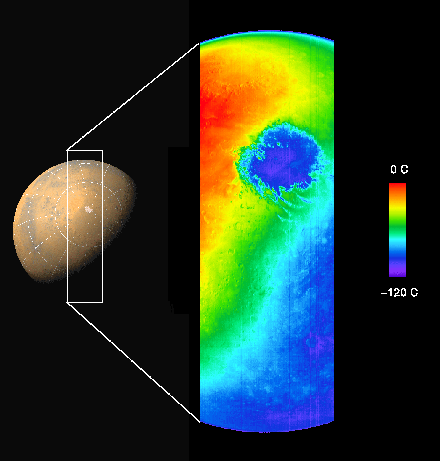
The spacecraft was approximately 22,000 kilometers from the planet and was looking toward the south pole of Mars when this image was taken.
The image was taken to test the camera system.
The image shows a 6,500 kilometers stretch of Mars, spanning the planet from limb to limb. The upper left part of the image shows a sunlight portion of the planet and the lower right part of the image shows part of the planet still in darkness.
The image resolution is approximately 5.5 kilometers per pixel at the point directly beneath the spacecraft. The Odyssey's infrared camera is expected to attain a resolution of 100 meters per pixel when it reaches its mapping orbit.
The image shows the temperature of Mars recorded through one of THEMIS's 10 thermal infrared filters. The temperatures detected range from a very cold -120°C up to 0°C. Different colours have been used to display the various temperatures recorded. The scale indicates the temperatures represented by the various colours.
The blue (extremely cold) circular feature is the martian south polar carbon dioxide ice cap at a temperature of about -120°C. The cap was more than 900 kilometers in diameter. When the image was taken, it was late spring in the martian southern hemisphere and the cap had begun to shrink. As summer progresses, it will shrink further.
Clouds of air blowing off the cap can be seen in orange extending across the image to the left of the cap.
The cold region in the lower right portion of the image is the cool nighttime surface of Mars. This portion of the image demonstrates the "night-vision" capability of the camera system.
The warmest regions occur near local noontime. The ring of mountains surrounding the 900-kilometer diameter impact basin Argyre can be seen in the early afternoon in the upper portion of the image.
The thin blue crescent along the upper limb of the planet is the martian atmosphere.
JPL manages the 2001 Mars Odyssey mission for NASA's Office of Space Science, Washington, D.C. The thermal emission imaging system was developed at Arizona State University, Tempe with Raytheon Santa Barbara Remote Sensing, Santa Barbara, Calif. Lockheed Martin Astronautics, Denver, Colo., is the prime contractor for the project, and developed and built the orbiter. Mission operations are conducted jointly from Lockheed Martin and from JPL, a division of the California Institute of Technology in Pasadena.
Source: MEDIA RELATIONS OFFICE, JET PROPULSION LABORATORY, CALIFORNIA INSTITUTE OF TECHNOLOGY NATIONAL AERONAUTICS AND SPACE ADMINISTRATION PASADENA, CALIF. 91109. TELEPHONE (818) 354-5011 http://www.jpl.nasa.gov
PHOTO CAPTION PIA-03459 2001 Mars Odyssey October 31, 2001